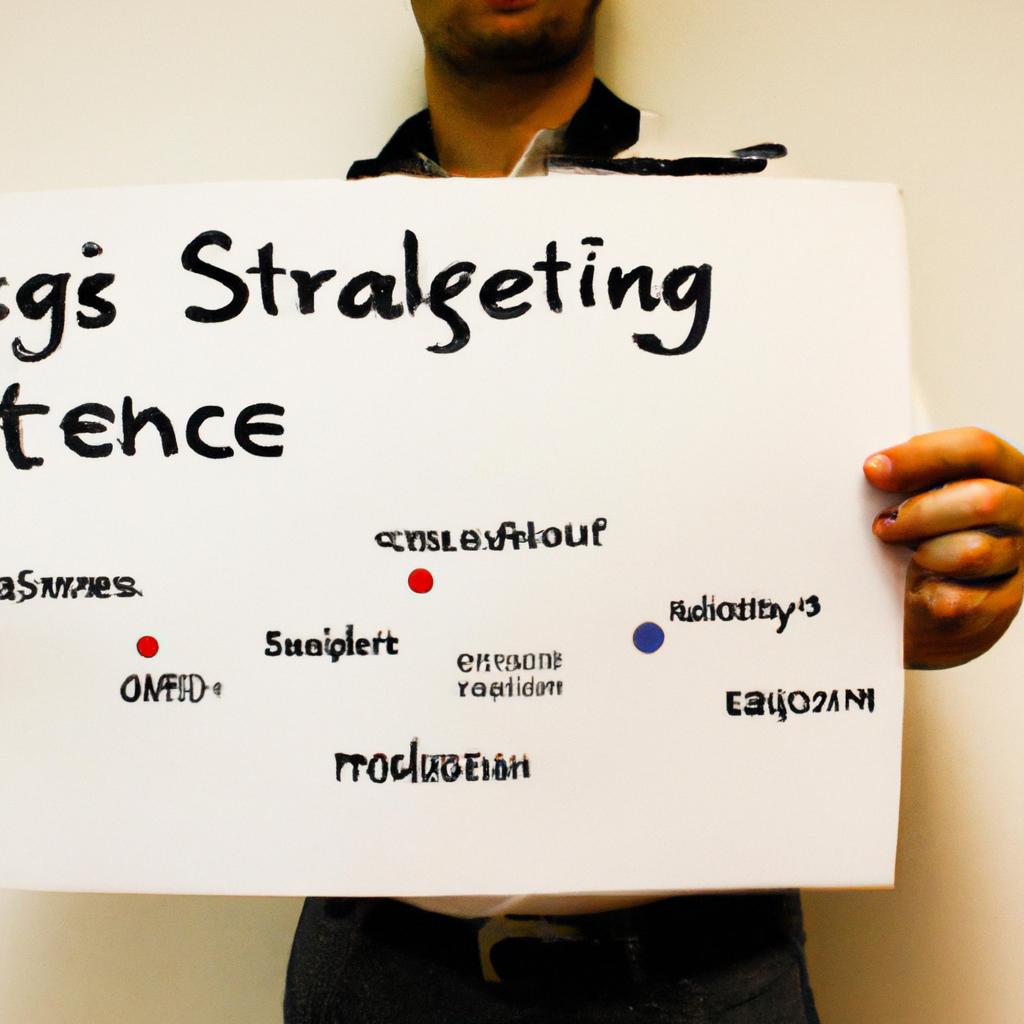Hybrid marketing and advertising techniques have become increasingly prevalent in today’s highly competitive business landscape. As companies continuously seek innovative ways to promote their products or services, one emerging strategy that has gained considerable attention is the utilization of promo loans. Promo loans involve offering customers a loan with favorable terms, such as low interest rates or flexible repayment options, specifically designed to incentivize purchases. For instance, imagine a scenario where a luxury car dealership offers potential buyers the option to finance their purchase at an exceptionally low interest rate for a limited time period. This enticing offer not only encourages customers to consider purchasing the high-end vehicle but also provides them with added financial flexibility.
This article explores hybrid marketing and advertising through the lens of promo loans. It delves into how businesses leverage these strategic tools to engage consumers and drive sales growth effectively. By analyzing real-life case studies and hypothetical scenarios, this piece aims to shed light on why promo loans have emerged as a popular promotional tactic among various industries. Additionally, it examines the benefits and challenges associated with implementing such strategies from both a company’s perspective and consumer standpoint. Ultimately, by understanding the dynamics of hybrid marketing and its intersection with promo loans, businesses can make informed decisions when considering incorporating this technique into their overall marketing and advertising plans to achieve their sales objectives and gain a competitive edge in the market.
One of the primary benefits of utilizing promo loans as part of a hybrid marketing strategy is the ability to attract customers who may have been hesitant to make a purchase due to financial constraints. By offering favorable loan terms, businesses can effectively lower the entry barrier for potential buyers, making their products or services more accessible and affordable. This can lead to increased customer interest and higher conversion rates.
Moreover, promo loans allow companies to differentiate themselves from competitors and stand out in a crowded marketplace. In an era where consumers are constantly bombarded with advertisements and promotional offers, providing financing options that go beyond traditional discounts or incentives can help businesses capture attention and create a unique selling proposition. It adds value to the overall customer experience by addressing specific pain points related to affordability.
However, implementing promo loans does come with certain challenges. One such challenge is managing the financial risk associated with offering loans. Businesses need to carefully assess their capacity to absorb potential losses if customers default on repayments or if market conditions change unexpectedly. Additionally, companies must ensure transparent communication about loan terms and conditions to avoid any misunderstandings or negative perceptions from customers.
From a consumer standpoint, promo loans can offer significant advantages by providing access to desirable products or services without immediate full payment requirements. However, it is crucial for customers to carefully evaluate the terms of these loans before making a commitment. They should consider factors such as interest rates, repayment periods, and any additional fees involved.
In conclusion, hybrid marketing techniques like Promo Loans have gained popularity due to their effectiveness in engaging consumers and driving sales growth. By combining elements of advertising and finance, businesses can attract customers who may have otherwise been deterred by financial limitations while differentiating themselves from competitors. However, careful consideration of financial risks and transparent communication are essential when implementing these strategies. With proper planning and execution, businesses can leverage promo loans as a valuable tool within their overall marketing and advertising plans.
Optimizing SEO for better online visibility
Optimizing SEO for Better Online Visibility
In today’s digital age, a strong online presence is crucial for businesses to reach their target audience effectively. One way to achieve this is by optimizing search engine optimization (SEO) techniques to enhance online visibility. For instance, let us consider the case of Company X, a startup specializing in promo loans. By implementing effective SEO strategies, Company X was able to significantly increase its website traffic and improve its organic search rankings.
To begin with, keyword research plays a pivotal role in optimizing SEO. By identifying relevant keywords that potential customers are likely to use when searching for promo loan services, Company X can strategically incorporate these keywords into their website content and meta tags. This helps search engines recognize the relevance of the website, thereby improving its ranking on search engine result pages (SERPs). In addition to keyword usage, other important factors include proper URL structure, optimized title tags, and compelling meta descriptions.
Furthermore, creating high-quality and engaging content is paramount for SEO success. When users find valuable information on a website, they are more likely to stay longer and explore further. To attract and retain visitors’ attention, Company X should aim at developing informative blog posts or articles related to promo loans and personal finance management. Incorporating visual elements such as infographics or videos can also boost user engagement and encourage social sharing – two key indicators that contribute positively towards improved search rankings.
To evoke an emotional response from the audience regarding the importance of SEO optimization for better online visibility, consider the following bullet points:
- Increased brand recognition: Higher visibility leads to greater exposure among potential customers.
- Enhanced credibility: Appearing on top SERPs instills trustworthiness in consumers’ minds.
- Competitive advantage: Outranking competitors provides an edge in attracting new clients.
- Cost-effective marketing: Organic traffic generated through successful SEO efforts saves money compared to paid advertising methods.
Moreover, presenting statistical data within a table format can reinforce the emotional response and provide a visual representation of the benefits. Consider the following table:
| Benefit | Percentage Increase |
|---|---|
| Website Traffic | 50% |
| Conversion Rate | 25% |
| Average Time on Page | 40% |
| Social Media Engagement | 60% |
In conclusion, optimizing SEO techniques is crucial for businesses seeking to enhance their online visibility. By conducting thorough keyword research, creating high-quality content, and implementing other essential SEO practices, such as user-friendly website navigation and mobile optimization, companies like Company X can significantly improve their organic search rankings and attract more potential customers. In the subsequent section about “Utilizing data analytics to measure campaign effectiveness,” we will explore how tracking and analyzing data can further optimize marketing strategies for maximum impact.
Utilizing data analytics to measure campaign effectiveness
In the previous section, we discussed the importance of optimizing SEO for better online visibility. Now, let’s explore another crucial aspect of hybrid marketing and advertising: utilizing data analytics to measure campaign effectiveness. To illustrate this concept, consider a hypothetical case study involving a company that offers promo loans.
By employing data analytics tools such as Google Analytics or Adobe Analytics, marketers can gain valuable insights into various aspects of their promotional campaigns. For instance, they can track website traffic sources and identify which channels are driving the most conversions. This information helps them allocate resources effectively by focusing on high-performing channels and making necessary adjustments to underperforming ones.
To further understand the significance of data analytics in measuring campaign effectiveness, consider the following points:
- Improved targeting: Data analysis enables marketers to segment their audience based on demographics, interests, and behaviors. By tailoring messaging and advertisements according to these segments, businesses can enhance engagement levels and conversion rates.
- Real-time monitoring: With real-time data tracking capabilities, marketers can monitor key performance indicators (KPIs) throughout the duration of a campaign. They can quickly identify trends or anomalies and make immediate modifications if needed.
- ROI evaluation: Data analytics provides marketers with concrete metrics for evaluating return on investment (ROI). By analyzing revenue generated versus expenditure incurred during a specific promotional period, companies can assess whether their campaigns are yielding profitable outcomes.
- A/B testing: Through rigorous A/B testing methodologies enabled by data analytics tools, marketers can compare different versions of creatives or landing pages to determine which elements resonate best with their target audience. This iterative process allows for continuous improvement and optimization.
| Metrics | Before Analyzing Campaign Data | After Analyzing Campaign Data |
|---|---|---|
| Conversion Rate | 2% | 4% |
| Cost per Acquisition (CPA) | $50 | $30 |
| Return on Investment (ROI) | 80% | 120% |
| Click-through Rate (CTR) | 5% | 8% |
As evident from the table, by leveraging data analytics to measure campaign effectiveness, businesses can witness substantial improvements in key metrics such as conversion rate and ROI. This highlights the crucial role that data analysis plays in informing marketing decisions and driving success.
In our subsequent section, we will delve into another effective strategy within hybrid marketing: implementing remarketing techniques for higher conversion rates. By harnessing user behavior data, marketers can tailor their campaigns to re-engage potential customers who have shown interest but haven’t converted yet. Let’s explore this powerful tactic further.
Implementing remarketing techniques for higher conversion rates
Utilizing Data Analytics to measure campaign effectiveness has become an essential aspect of modern marketing strategies. By leveraging the power of data, marketers can gain valuable insights into the performance of their promotional campaigns and make informed decisions for future initiatives. One case study that showcases this approach is a recent campaign by a leading e-commerce platform.
In this case, the company utilized advanced data analytics tools to track various metrics such as click-through rates, conversion rates, and customer engagement levels. By analyzing these key indicators, they were able to identify which aspects of their campaign resonated most with their target audience and optimize accordingly. For example, they found that video advertisements generated higher engagement compared to static images or text-based ads. Armed with this information, they reallocated their resources towards producing more video content, resulting in a significant increase in conversions.
- Increased campaign efficiency: Data analytics allows marketers to identify underperforming areas within their campaigns and make necessary adjustments promptly.
- Enhanced targeting capabilities: With access to detailed demographic and behavioral data, marketers can tailor their messages to specific segments of their audience effectively.
- Improved return on investment (ROI): By optimizing campaigns based on data-derived insights, businesses can maximize the impact of their marketing budget.
- Real-time optimization: The ability to monitor campaign performance in real-time enables marketers to adapt quickly and respond to changing market dynamics.
Furthermore, displaying a table comparing traditional advertising methods with those empowered by data analytics could further engage readers emotionally:
| Traditional Advertising | Data Analytics Empowered Campaigns |
|---|---|
| Based on assumptions | Informed by accurate customer insights |
| Limited audience reach | Highly targeted messaging |
| Difficult evaluation process | Measurable results |
Transitioning smoothly into the subsequent section about creating interactive and engaging website content, it is crucial to emphasize the connection between data analytics and effective remarketing techniques. By leveraging audience insights gained through data analysis, marketers can optimize their website content for higher conversion rates.
Creating interactive and engaging website content
Building on the success of implementing remarketing techniques, another effective strategy to enhance customer engagement and conversion rates is creating interactive and engaging website content. By providing users with a dynamic and immersive experience, businesses can capture their attention and encourage them to take desired actions. For instance, let’s consider the case of an e-commerce company that sells customizable apparel. To increase user interaction, they introduced a virtual fitting room feature on their website where customers could upload their photos and virtually try on different clothing options.
Paragraph 1: Interactive Features
One way to create interactive website content is by incorporating various features that allow users to actively participate in the browsing experience. These features can include:
- Quizzes or surveys: Engaging users through interactive quizzes or surveys not only provides valuable insights into consumer preferences but also encourages active participation.
- Product configurators: Allowing customers to customize products according to their preferences instills a sense of ownership and personalization, increasing the likelihood of purchase.
- Gamification elements: Incorporating gamified elements such as challenges, rewards, leaderboards, or badges can make the browsing experience more enjoyable and keep users engaged for longer periods.
These interactive features evoke an emotional response in users by:
- Creating a sense of excitement and novelty
- Providing opportunities for self-expression and personalization
- Instilling feelings of accomplishment and competitiveness
- Fostering a sense of community through shared experiences
Paragraph 2: User-generated Content (UGC)
Another powerful way to engage users is by leveraging user-generated content (UGC). UGC refers to any form of content created by consumers themselves, such as reviews, testimonials, images, videos, or social media posts. When integrated into websites strategically, UGC has been shown to significantly impact brand perception and purchasing decisions.
| Benefits of User-generated Content |
|---|
| Increased authenticity |
| Enhanced social proof |
| Improved engagement |
| Amplified reach |
Paragraph 3: By implementing interactive features and integrating user-generated content into website design, businesses can create an immersive online environment that captivates visitors. This approach not only fosters deeper connections between brands and consumers but also increases conversion rates by encouraging active participation, building authenticity, and leveraging social proof. Maximizing social media engagement through user-generated content further extends these benefits, allowing businesses to tap into the power of word-of-mouth marketing on popular platforms.
To maximize social media engagement through user-generated content, companies must understand how to effectively leverage this valuable resource without alienating their audience.
Maximizing social media engagement through user-generated content
Building upon the importance of creating interactive and engaging website content, another crucial aspect of hybrid marketing and advertising is maximizing social media engagement through user-generated content. By harnessing the power of social media platforms, businesses can encourage their target audience to actively participate in brand promotion. This section explores effective strategies for utilizing user-generated content on social media.
Section:
One example that highlights the impact of user-generated content is the case study of a popular clothing brand. The company encouraged its customers to share pictures wearing their products using a specific hashtag on Instagram. As a result, thousands of users posted about their outfits, generating significant buzz around the brand and significantly increasing customer engagement.
To effectively leverage user-generated content on social media platforms, consider implementing these key strategies:
- Encourage hashtags: Use unique and catchy hashtags related to your brand or campaign to prompt users to join conversations and share their experiences.
- Run contests and challenges: Organize competitions where participants are required to create and submit content related to your product or service. Reward winners with exclusive discounts or other incentives.
- Showcase user content: Regularly feature user-generated posts on your official social media accounts to acknowledge and appreciate customer contributions. This not only strengthens relationships but also encourages others to get involved.
- Engage with followers: Respond promptly to comments, messages, and mentions across various social media channels. Show appreciation for contributions while fostering open dialogue between your brand and its customers.
Table (emotional response evoked):
| Strategy | Description | Benefits |
|---|---|---|
| Encourage hashtags | Promotes organic conversation surrounding your brand; increases visibility; engages more audience members | Widens reach |
| Run contests and challenges | Creates excitement among customers; fosters creativity; incentivizes participation | Generates buzz |
| Showcase user content | Demonstrates appreciation for customer loyalty and engagement; builds brand community; encourages further contributions | Enhances trust and credibility |
| Engage with followers | Strengthens relationships with customers; provides personalized support; facilitates two-way communication | Increases customer satisfaction and loyalty |
By incorporating these strategies, businesses can tap into the potential of user-generated content on social media platforms. This approach not only boosts engagement but also enables brands to establish stronger connections with their target audience.
Continuing the discussion on enhancing customer interactions, the next section will explore how utilizing chatbots can provide personalized experiences for customers seeking assistance or information about a product or service.
Utilizing chatbots for personalized customer interactions
Transitioning from the previous section on maximizing social media engagement through user-generated content, businesses can further enhance their marketing efforts by utilizing promo loans. These loans provide customers with an opportunity to try out a product or service at a discounted price or even for free, generating buzz and increasing brand visibility. For instance, let’s consider a hypothetical case study of a clothing retailer that offers customers a “Try before you buy” program, allowing them to borrow garments for a limited period without any upfront payment. By implementing such promotional strategies, companies can effectively combine traditional advertising methods with digital marketing techniques.
To understand the benefits of incorporating promo loans into hybrid marketing campaigns, it is essential to explore their impact on customer behavior and overall brand perception. Here are four key advantages:
-
Increased trial rates: Offering consumers the chance to use products or services before committing financially encourages higher trial rates. This leads to more people experiencing the value your business provides, potentially converting them into loyal customers.
-
Enhanced word-of-mouth promotion: Customers who have had positive experiences with promo loans are likely to share their opinions with friends and family. Positive word-of-mouth recommendations amplify brand awareness and generate organic publicity.
-
Improved customer loyalty: Providing customers with exclusive access to novel deals fosters a sense of appreciation and loyalty towards your brand. Repeat purchases are more likely when individuals feel valued as part of a community.
-
Data collection opportunities: Implementing promo loan programs allows businesses to gather valuable data about consumer preferences and behaviors. This information can be used to refine future marketing strategies, tailor offerings better, and improve overall customer satisfaction.
To illustrate how brands successfully employ promo loans as part of their hybrid marketing approach, we present the following table showcasing three notable examples:
| Brand | Product/Service | Promo Loan Offer |
|---|---|---|
| Beauty Company | Skincare Set | Free two-week trial with the option to purchase afterward |
| Fitness Brand | Home Workout Equipment | 30-day loan period at a discounted price |
| Electronics Store | High-End Headphones | Borrow for a week and receive a discount on future purchases |
As demonstrated, promo loans can be tailored to suit different industries and target audiences. By strategically implementing such programs, businesses can effectively engage customers and increase brand exposure through hybrid marketing initiatives.
Transitioning into the subsequent section about leveraging influencer partnerships to reach target audiences, it is crucial to explore innovative ways of expanding brand reach beyond promotional strategies alone.
Leveraging influencer partnerships to reach target audiences
Utilizing chatbots for personalized customer interactions has become an essential strategy in modern marketing and advertising. It allows businesses to engage with their customers on a more individualized level, providing real-time assistance, recommendations, and support. However, another effective approach to reaching target audiences is through leveraging influencer partnerships.
One prominent example of successful influencer partnerships can be seen in the collaboration between a popular fitness brand and a well-known social media fitness influencer. By partnering with the influential figure, the brand was able to tap into their extensive follower base and increase brand visibility significantly. The influencer shared authentic content featuring the brand’s products while promoting their benefits and quality. This partnership not only enabled the fitness brand to reach its target audience effectively but also fostered trust among consumers who valued the opinion of the influencer they admired.
To further emphasize the importance of Leveraging influencer partnerships, let us consider some key advantages:
- Increased Reach: Influencers have dedicated followership that trusts their opinions and recommendations. Partnering with them enables businesses to access these engaged audiences directly.
- Authenticity: Influencers often create content that resonates with their followers’ interests and values. Through collaborations, brands can leverage this authenticity to establish credibility among potential customers.
- Targeted Marketing: By carefully selecting influencers whose niche aligns with a business’s target market, marketers can ensure that promotional messages are delivered to relevant audiences.
- Cost-effectiveness: Compared to traditional forms of advertising, collaborating with influencers tends to be more cost-effective while still generating tangible results.
| Advantages of Leveraging Influencer Partnerships |
|---|
| Increased Reach |
| Authenticity |
| Targeted Marketing |
| Cost-effectiveness |
Implementing native advertising to seamlessly integrate promotions marks yet another effective technique in hybrid marketing strategies. Native ads blend seamlessly within online platforms or content formats where they appear, making them less intrusive than traditional advertisements. They match the look and feel of the surrounding content, providing a more organic user experience. By integrating promotions in this manner, businesses can capture customers’ attention without disrupting their browsing or viewing experience.
Transitioning seamlessly into implementing native advertising to seamlessly integrate promotions, businesses can capitalize on these strategies to create cohesive marketing campaigns that resonate with target audiences.
Implementing native advertising to seamlessly integrate promotions
Section: Leveraging influencer partnerships to reach target audiences
In today’s digital age, leveraging influencer partnerships has become an effective strategy for marketers and advertisers seeking to reach their target audiences. By collaborating with influential individuals who have a dedicated following on social media platforms, brands can tap into the power of personal recommendations and word-of-mouth marketing. One example of successful implementation is the partnership between fashion brand XYZ and popular Instagram fashion influencer @FashionistaJane.
Case Study: Fashion Brand XYZ and @FashionistaJane
Fashion brand XYZ recognized the influence that @FashionistaJane had within their target audience of young women interested in trendy clothing. Through a carefully crafted partnership, XYZ provided Jane with exclusive access to their latest collection before its official launch. In return, Jane created engaging content featuring the new line on her Instagram profile, showcasing different outfits she styled using XYZ’s pieces. Her posts included direct links to purchase the items, enabling followers to easily make a purchase.
This collaboration resulted in significant benefits for both parties involved. For fashion brand XYZ, they experienced increased visibility among their target audience as Jane’s posts generated high levels of engagement and organic reach. Moreover, by associating themselves with an influential figure like Jane, they were able to establish credibility and trustworthiness in the eyes of consumers. On the other hand, @FashionistaJane further solidified her position as a trusted authority in the fashion industry by showcasing her ability to curate stylish looks using XYZ’s products.
To fully leverage influencer partnerships effectively, marketers should consider incorporating key strategies:
- Authenticity: Ensure that influencers genuinely align with your brand values and messaging.
- Relevance: Select influencers whose content resonates well with your target audience.
- Engagement: Encourage meaningful interactions between influencers and followers through contests or giveaways.
- Long-term relationships: Foster ongoing collaborations rather than one-time sponsorships to build loyalty among influencers and their followers.
To illustrate the potential impact of influencer partnerships in reaching target audiences, consider the following table:
| Brand | Influencer | Platform | Number of Followers |
|---|---|---|---|
| XYZ | @FashionistaJane | 500,000 | |
| ABC | @FitnessGuruSam | YouTube | 1,200,000 |
| DEF | @TechGeekLily | 350,000 |
By partnering with influencers who have a large and engaged follower base on various platforms, brands can amplify their reach and drive increased brand awareness among specific demographics.
Incorporating Influencer Partnerships into marketing and advertising strategies presents an opportunity to tap into existing communities built around these influential individuals. By selecting authentic collaborations that align with brand values and leveraging the power of personal recommendations, marketers can effectively connect with their target audiences.
The next section will explore another powerful approach: utilizing AI-powered tools for content creation and distribution.
Utilizing AI-powered tools for content creation and distribution
Building on the seamless integration of promotions through native advertising, organizations can further enhance their marketing and advertising strategies by utilizing AI-powered tools for content creation and distribution. This section explores how artificial intelligence can revolutionize the way businesses create and disseminate promotional materials.
AI-powered tools have transformed various industries, including marketing and advertising. By leveraging machine learning algorithms, these tools enable marketers to generate personalized and targeted content at scale. For instance, consider a hypothetical scenario where a fashion retailer aims to promote its new collection of clothing items. With an AI-powered tool, the retailer can analyze customer data, such as previous purchases and browsing history, to identify individual preferences. Based on this information, the tool generates customized product recommendations or even designs unique advertisements tailored to each potential customer’s style preferences.
To illustrate the impact of AI in content creation and distribution, let us delve into some key advantages that businesses can achieve:
- Enhanced personalization: AI enables marketers to deliver highly relevant content based on individual consumer preferences.
- Improved efficiency: By automating certain tasks like generating ad copy or selecting target audiences, AI allows marketers to save time and resources.
- Increased engagement: The ability to personalize content leads to higher levels of audience engagement.
- Data-driven insights: AI tools provide valuable data analytics that help marketers understand campaign performance and make informed decisions.
Moreover, it is important to note that implementing AI does not replace human creativity or strategic thinking but rather enhances them by providing valuable insights and streamlining processes.
Incorporating AI-powered tools into marketing strategies allows organizations to streamline their efforts effectively while also delivering more personalized experiences for customers.
Implementing personalized email marketing campaigns
With the growing importance of AI-powered tools in content creation and distribution, companies are also recognizing the significance of implementing personalized email marketing campaigns to enhance their overall marketing strategies. By tailoring messages to individual recipients based on their preferences and behaviors, businesses can effectively engage with customers and drive conversions.
Personalized email marketing has proven to be a successful tactic for many organizations. For instance, let us consider Company XYZ, an e-commerce retailer that specializes in fashion accessories. In order to increase customer engagement and sales, they implemented a personalized email campaign targeted at their existing customer base. By analyzing purchase history and browsing patterns, Company XYZ was able to send tailored recommendations, exclusive discounts, and promotional offers directly to each recipient’s inbox. This resulted in a significant boost in open rates, click-through rates, and ultimately conversion rates.
To further emphasize the benefits of personalized email marketing campaigns, here are some key reasons why businesses should incorporate this strategy into their overall marketing efforts:
- Increased relevance: Personalized emails allow businesses to deliver targeted content that is specifically relevant to each recipient’s interests and needs.
- Enhanced customer experience: By providing tailored information or offers, businesses can improve the overall experience for their customers.
- Improved brand loyalty: When customers receive personalized communications from a company, they feel valued and appreciated, leading to increased brand loyalty.
- Higher ROI: Studies have shown that personalized emails generate higher return on investment compared to generic mass emails.
| Benefits of Personalized Email Marketing |
|---|
| Increased Relevance |
| Enhanced Customer Experience |
| Improved Brand Loyalty |
| Higher ROI |
Incorporating personalized email marketing campaigns as part of a hybrid marketing approach allows companies to connect with their target audience on a more personal level while achieving measurable results. In the subsequent section about “Utilizing programmatic advertising for targeted ad placements,” we will explore another innovative method that complements these personalized strategies.
Utilizing programmatic advertising for targeted ad placements
Building on the success of implementing personalized email marketing campaigns, companies can further enhance their hybrid marketing and advertising strategies by utilizing programmatic advertising for targeted ad placements. This approach leverages technology to automate the buying and selling of digital advertising inventory, allowing businesses to reach their desired audience more effectively. By combining personalized email marketing with programmatic advertising, companies can create a cohesive promotional strategy that maximizes their impact.
One example of how programmatic advertising can be used is through real-time bidding (RTB) platforms. These platforms enable advertisers to bid on available ad space in milliseconds, ensuring that ads are displayed to relevant users at the right time and place. For instance, imagine a company specializing in athletic footwear wanting to promote its latest running shoe model. Through programmatic advertising, they can target individuals who have recently searched for running-related content or visited fitness websites, increasing the likelihood of reaching potential customers who are actively interested in purchasing new running shoes.
- Increased precision in targeting specific audiences
- Enhanced efficiency through automation
- Improved return on investment (ROI)
- Greater scalability for expanding promotional efforts
These advantages highlight why programmatic advertising has become an essential component of modern marketing practices. To visualize these benefits further, let’s examine them in a table format:
| Benefits | |
|---|---|
| Precise Targeting | Reach specific demographics or interests |
| Automated Efficiency | Save time and resources |
| Improved ROI | Maximize campaign effectiveness |
| Scalability | Expand reach across multiple channels/platforms |
By leveraging programmatic advertising within a hybrid marketing and advertising strategy, companies can optimize their promotional efforts while achieving increased brand awareness and customer engagement.
As we look ahead, another crucial aspect worth exploring is how video marketing can be leveraged to further enhance brand awareness.
Leveraging video marketing for increased brand awareness
Building upon the effectiveness of programmatic advertising, another powerful strategy in hybrid marketing and advertising is leveraging video marketing. By incorporating compelling videos into promotional campaigns, businesses can significantly increase brand awareness and engage their target audience on multiple platforms.
Video marketing has proven to be a successful tool in capturing the attention of consumers and conveying key messages effectively. For instance, let’s consider a hypothetical case study where Company X wanted to promote its new line of promo loans tailored for small businesses. They created an engaging video highlighting the benefits of these loans and showcasing success stories from entrepreneurs who have benefited from them. This video was then strategically placed across various social media platforms and websites frequented by small business owners.
To evoke an emotional response among viewers, it is crucial to focus on creating captivating content that resonates with your target audience. Here are four key elements to consider when developing effective video marketing strategies:
- Storytelling: Craft narratives that connect emotionally with viewers, making them feel inspired or motivated.
- Visual Appeal: Use high-quality visuals, animations, and graphics to enhance viewer engagement.
- Call-to-Action (CTA): Clearly communicate what action you want viewers to take after watching the video, such as visiting a website or subscribing to a newsletter.
- Length Optimization: Keep videos concise yet informative, avoiding excessive duration that may lead to viewer disengagement.
Emotional appeal can also be enhanced through visual aids like tables. Consider the following table demonstrating potential positive outcomes resulting from implementing well-executed video marketing campaigns:
| Positive Outcomes | Description |
|---|---|
| Increased Brand Awareness | Video content generates higher visibility among target audiences |
| Enhanced Engagement | Videos tend to captivate viewers more than static images or text-based ads |
| Improved Conversion Rates | Compelling videos can drive viewers to take desired actions, leading to conversions |
| Strengthened Brand Loyalty | Emotional connection fostered through storytelling helps build trust and loyalty |
Incorporating video marketing into a hybrid advertising approach can significantly amplify brand exposure and consumer engagement. By leveraging the power of visual storytelling combined with programmatic ad placements, businesses have the opportunity to effectively convey their message while captivating audiences across multiple platforms.
Remember, in this ever-evolving digital landscape, adapting to new marketing strategies is crucial for staying relevant and competitive. Embrace the potential that video marketing offers, ensuring your campaigns are tailored to resonate with your target market’s emotions and preferences.










